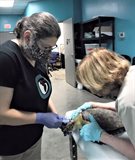
Well, it was nice while it lasted. We should have known better than to think that those above-average temperatures would continue until spring. And if we thought for even one minute that this was maybe, just maybe the year we wouldn’t be seeing an influx of NC cold-stuns in late January and early February our hopes were just that - hopes. We recently admitted seven little greens, all frosty and covered with barnacles. Clearly, we were tempting fate by “saving room in sick bay, just in case.”
Our new Executive Director, Kathy Zagzebski is now on site, fresh from the National Marine Life Center in Massachusetts where she spent the winter wrangling over two-hundred cold stun Kemp’s. Having only seven newbies to greet you on your first week on the job was probably a relief. These critters are not the worst of the worst, at least on the outside. But you just never know what you’re going to run up against once they’ve warmed up and are swimming and eating on a regular basis. Bad stuff can happen as time goes by, so our volunteers are vigilant in observing and passing along any changes in appearance or behavior of these critters.
For example, if a turtle suddenly stops eating is it because they don’t like what we’re serving for breakfast anymore? We’ll dig into our food arsenal (fish, like capelin, mackerel, blues) and squid and shrimp to see if we can hit the target. Sometimes it’s just adjusting the presentation of the food – not that we spoil our patients! We have turtles that like squid but only the heads, or everything but the heads, and cut to a certain size. To get some calcium into the “squid turtles” we secrete fish inside the squid body, hoping they don’t notice our deception. But some are very adept at managing to eat only the body and then mocking our efforts by strewing untouched fish around their tank. And now we have a growing list of turtles who will only eat in the afternoon.
We’ve had turtles that won’t eat if you’re looking at them. Our staff would be quick to tell you the tale of “Honey Bee,” the Kemp’s that would not eat until we physically moved her into a small black tank every morning at breakfast. Then we had to step away and toss the food at her a few pieces at a time like manna from turtle heaven. Honey Bee was released last year but no word if she ever found a small black tank conducive to dining.
So, North Carolina cold-stun season appears to be officially here, and as usual we’re relying on our locals and visitors to keep an eye out for turtles in trouble. They may be on the beach, in marshy areas or floating in the water. If you spot one gently pick them up and then follow a few basic steps. Take them to an unheated but sheltered place, like your car or your garage. You may be tempted to warm them up but that’s the worst thing you can do. Turtles are reptiles and cannot regulate body temperature so forcing their body to adjust quickly to a heated environment could send them into shock. Then call our Director of Beach Operations, Terry Meyer at 910-470-2880 or our hospital at: 910-329-0222. NC Wildlife Resources also has an Emergency hotline number that picks up 24/7: 252-241-7367.



